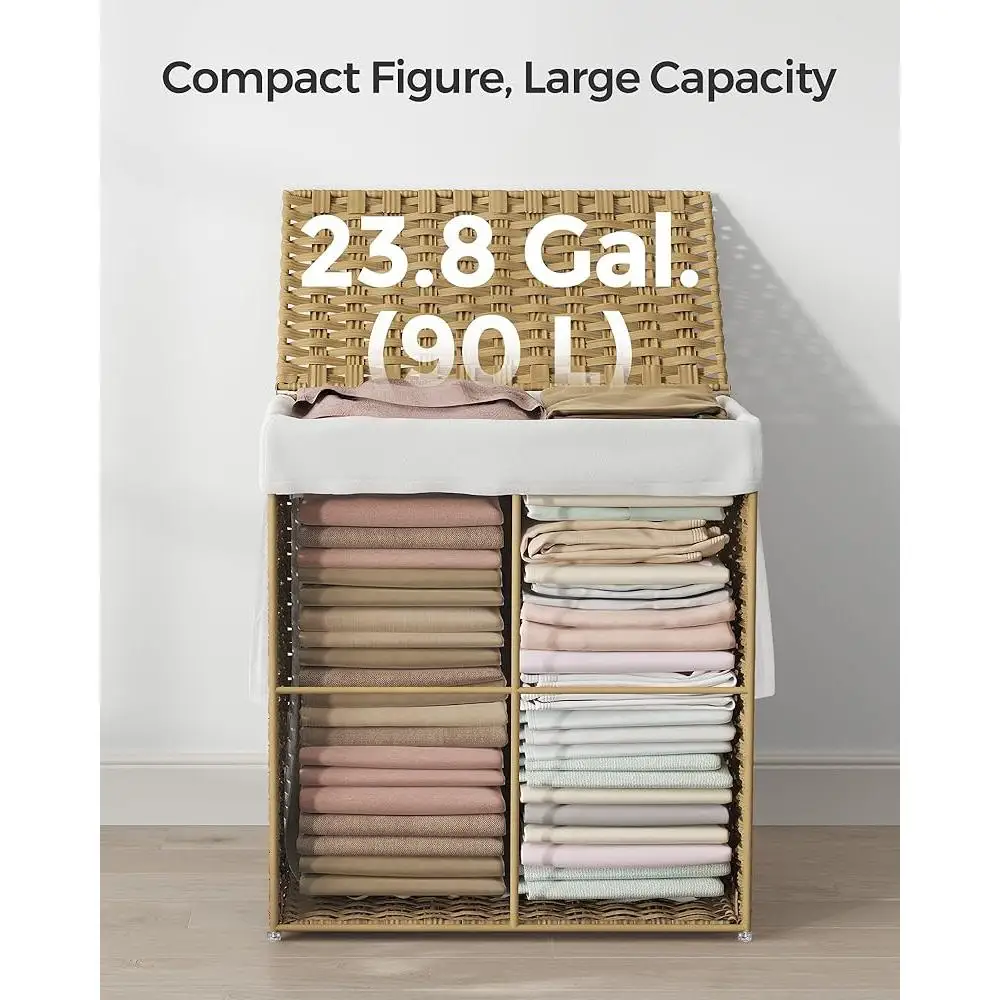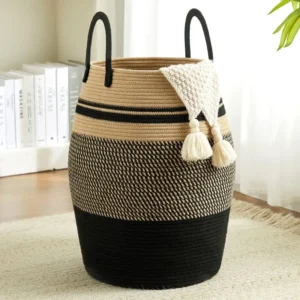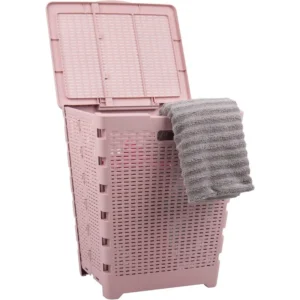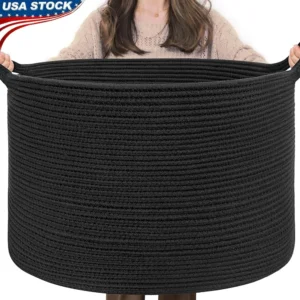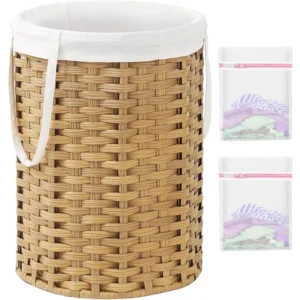Introduction: The Importance of Choosing the Right Laundry Hamper
A laundry hamper is more than just a container for dirty clothes—it’s an essential home organization tool that helps maintain tidiness while keeping soiled items separate until laundry day. Whether in a bedroom corner, bathroom, or dedicated laundry area, these practical vessels play a surprising role in our daily routines.
One of the most common questions homeowners face when selecting a hamper is whether to choose one with a lid. This seemingly simple decision can significantly impact functionality, aesthetics, and even the freshness of your home. The right choice depends on various personal factors including your specific laundry habits, living situation, and home environment.
In this comprehensive guide, we’ll explore the benefits and potential drawbacks of lidded hampers, analyze how your unique circumstances might influence your decision, and provide practical advice to help you make the right choice. From odor control and visual appeal to ventilation concerns and convenience factors, we’ll cover all the key considerations to help you determine if the transformative benefits of lidded laundry hampers are right for your home.
The Benefits of Choosing a Laundry Hamper With a Lid
Before making your decision, it’s important to understand the numerous advantages that lidded hampers offer over their open-top counterparts. These benefits explain why many homeowners ultimately choose lidded laundry hampers for their homes.
Effective Odor Containment: Perhaps the most compelling reason to choose a lidded hamper is its ability to trap and contain odors. Sweaty gym clothes, damp towels, and heavily soiled items can quickly create unpleasant smells in your living space. A quality lid creates a physical barrier that helps keep these odors contained rather than wafting throughout your home. This is especially valuable in smaller living spaces where lidded hampers designed for odor control can make a significant difference in maintaining freshness.
Enhanced Room Aesthetics: A lidded hamper offers the simple yet valuable benefit of concealing dirty laundry from view. This creates a tidier, more visually appealing space without the constant reminder of pending laundry tasks. For those who value a clean, organized appearance in bedrooms and bathrooms, a lidded option transforms a functional necessity into a complementary design element.
Improved Home Hygiene: Lidded hampers provide an additional hygiene barrier by containing allergens, dust, and bacteria that might be present in soiled clothing. This containment helps reduce the spread of these particles throughout your living space, potentially benefiting those with allergies or respiratory sensitivities.
Pet and Child Deterrence: For households with curious pets or young children, lidded hampers offer practical protection against unwanted exploration. The physical barrier prevents pets from turning laundry into toys and keeps small children from pulling out items you’d rather keep contained.
Secure Containment: Lidded designs excel at keeping laundry where it belongs—inside the hamper. They prevent overflow and spillage, especially with taller hamper designs that might otherwise allow items to tumble out when filled to capacity. This containment feature helps maintain order even as the hamper fills throughout the week.
Potential Drawbacks of Lidded Laundry Hampers
While lidded hampers offer numerous benefits, a balanced decision requires understanding their potential limitations as well. When comparing lidded vs. open laundry hampers, these considerations might influence your choice.
Reduced Air Circulation: The most significant concern with lidded hampers is their potential to restrict airflow. Limited ventilation can create a humid environment inside the hamper, potentially leading to musty odors or even mildew growth if damp items are stored for extended periods. This issue becomes particularly relevant for workout clothes, wet towels, or laundry stored in already humid environments like bathrooms.
Decreased Convenience: The extra step of opening and closing a lid may seem minor, but it can become inconvenient in daily use—especially when your hands are full with a bundle of clothes. This added effort might lead to clothes being placed on top of or beside the hamper rather than inside it, defeating the organizational purpose.
Out of Sight, Out of Mind: When dirty laundry is concealed behind a lid, it’s easier to forget about it. This “invisible laundry” effect can sometimes lead to less frequent washing cycles or unexpected surprises when you finally open the hamper to find it completely full. For households that benefit from visual reminders to do laundry, this hidden aspect can be counterproductive.
Space and Cost Considerations: Lidded hampers typically require slightly more vertical clearance than open models and often come with a higher price point. While the difference might be minimal, these factors can matter in tight spaces like closets or when working within a specific budget.
For many households, these potential drawbacks can be managed with thoughtful hamper selection and placement. The key is understanding whether the specific benefits of a lid outweigh these considerations for your particular situation.
Understanding Your Laundry Habits: A Critical Factor in Your Decision
Your personal laundry patterns play a crucial role in determining whether a lidded hamper makes sense for your home. These daily habits often reveal more about your ideal hamper than you might initially realize.
Clothing Types and Their Requirements
The specific items that typically fill your hamper should heavily influence your decision. Consider how your laundry generally breaks down:
- Heavily soiled or sweaty clothes: If your hamper regularly contains workout gear, work uniforms, or children’s play clothes, a lid becomes particularly valuable for containing odors and separating these items from your living environment.
- Damp items: Towels, swimwear, or clothes caught in the rain present special considerations. While these items benefit from odor containment, they also need sufficient air circulation to prevent mildew development.
- Everyday wear: Regular clothing that isn’t particularly soiled or damp generally creates fewer specialized storage requirements, making the lid decision more about aesthetics and organization than functional necessity.
Laundering Frequency
How often you wash clothes significantly impacts your hamper needs. Households that do laundry daily or every few days may find that clothes don’t remain in the hamper long enough for odors or moisture to become problematic, potentially making a lid unnecessary. Conversely, those who launder weekly or less frequently might find a lid essential for odor management during the longer storage period.
Household Size
Larger households naturally generate more laundry, which may mean either more frequent washing or larger hamper capacity. This volume consideration affects both the size of hamper needed and whether a lid becomes more important for managing the increased quantity of items. When comparing laundry hampers vs. baskets for larger families, capacity and containment often become priority factors.
By honestly assessing these personal factors, you’ll gain clarity about whether a lid addresses your specific needs or adds unnecessary complexity to your laundry routine.
How Your Home Environment Influences Your Hamper Choice
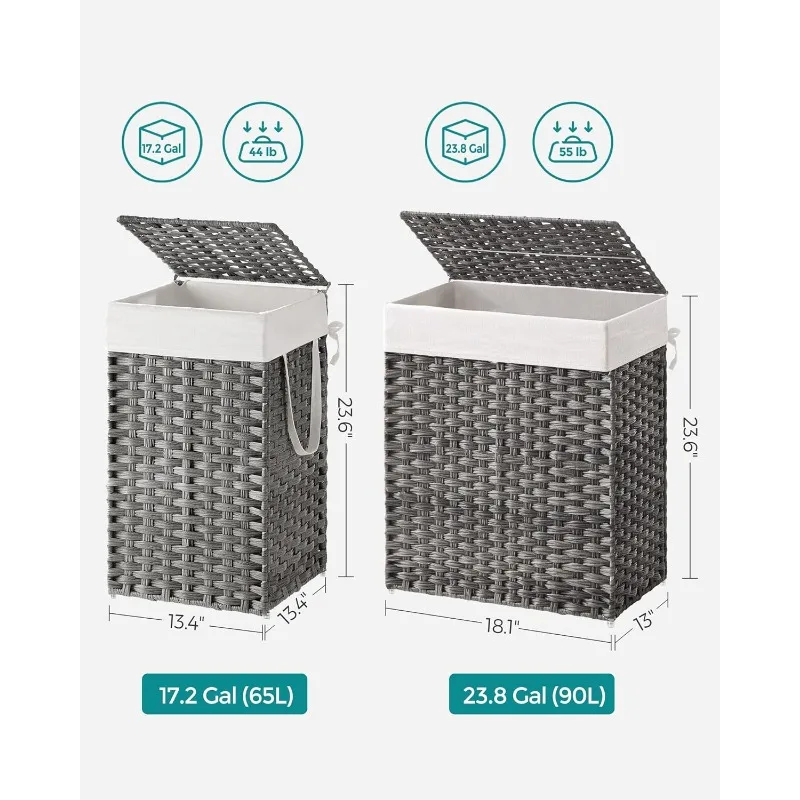
Beyond your personal habits, your physical living environment plays a significant role in determining the ideal hamper configuration. Different locations within your home create distinct requirements that may favor either lidded or open designs.
Bedroom Placement
Hampers in bedrooms typically benefit from lids for both aesthetic and practical reasons. Bedrooms serve as personal sanctuaries and places of rest, making visual tidiness particularly important. A lid conceals laundry from view, contributing to a more peaceful, organized environment. Additionally, since bedrooms often have less ventilation than other areas, containing potential odors becomes more valuable.
Bathroom Location
Bathrooms present unique challenges for hamper placement due to their naturally humid environment. While bathroom laundry baskets with lids can help maintain visual order in this highly visible space, the moisture-rich environment requires careful consideration. If your bathroom has good ventilation, a lidded hamper may work well. However, in smaller or poorly ventilated bathrooms, an open design might better prevent mildew by allowing damp towels and clothes to dry more effectively.
Closet Positioning
Closets often have limited airflow, making them challenging locations for laundry storage. A lidded hamper in a closet can help keep clothing odors contained within the hamper rather than permeating your clean clothes. However, this limited ventilation also means moisture may become trapped. For closet placement, consider hampers with partial ventilation features that balance airflow with odor containment.
Laundry Room Placement
In dedicated laundry spaces, functionality often takes precedence over aesthetics. Since these areas are typically separated from living spaces, the odor-containing benefits of lids become less critical. Many households find that open hampers work well in laundry rooms, facilitating easy sorting and loading of the washing machine.
Household Member Considerations
The presence of pets or small children often tips the scales toward lidded options. Curious pets may see open hampers as toy boxes or comfortable napping spots, while toddlers might enjoy emptying hamper contents onto the floor. A secure lid can prevent these scenarios while maintaining organization.
By carefully assessing where your hamper will live and who might interact with it, you can better determine whether a lid would be a helpful feature or an unnecessary hindrance in your specific home environment.
Lid Types and Materials: Finding the Perfect Combination
The effectiveness of a lidded hamper depends significantly on both the lid design and the materials used in construction. Understanding these elements helps you select an option that addresses your specific needs without introducing unwanted drawbacks.
| Lid Type | Best For | Potential Limitations |
|---|---|---|
| Hinged | Convenience, one-handed operation | May break at hinge point with frequent use |
| Removable | Maximum ventilation when needed | Can be misplaced when separated from hamper |
| Flip-top | Easy access, stays attached | Often less secure closure than other types |
| Magnetic | Secure closure, quiet operation | May lose magnetism over time |
Material Impact on Performance
The material composition of your hamper and lid significantly affects its functionality across several important dimensions:
Breathable Materials: Natural materials like wicker, rattan, bamboo, and cotton offer the advantage of allowing some air circulation even when the lid is closed. These wicker hampers with lids strike an excellent balance between containment and ventilation, helping prevent the mildew problems that can plague completely sealed containers. The natural weave creates tiny air passages that allow moisture to escape while still providing visual coverage and significant odor reduction.
Non-breathable Materials: Solid plastic or metal hampers provide maximum odor containment and are typically easier to clean, but they completely restrict airflow. This makes them excellent for certain applications (like diaper hampers) but potentially problematic for general laundry that may include damp items.
Ventilation Considerations
The ideal hamper often combines solid and ventilated elements to balance competing needs. Some premium designs feature solid bodies with ventilated lid sections or strategic airflow channels that maintain circulation without compromising containment. These thoughtful design elements address the primary concern with lidded options while preserving their benefits.
Aesthetic Integration
Beyond pure functionality, material choice significantly impacts how well your hamper integrates with your home décor. Natural materials like wicker and rattan offer timeless appeal and tend to complement a wide range of interior styles, from traditional to contemporary coastal designs. When selecting your hamper, consider how its material and finish will coordinate with your existing furnishings and color scheme.
When a Lidded Hamper Is Highly Recommended: Specific Scenarios
While individual preferences vary, certain situations strongly favor lidded hamper designs. If your circumstances align with any of these scenarios, you’ll likely benefit significantly from choosing a hamper with a lid.
Small Living Spaces: In apartments, studio units, or dorms where living areas serve multiple functions, lidded hampers become particularly valuable. These compact environments allow odors to permeate quickly, and limited space means dirty laundry may be stored near seating, sleeping, or dining areas. A lid creates necessary separation between living activities and laundry storage.
Households with Curious Pets: If you share your home with dogs or cats, you’re likely familiar with their interest in investigating open containers. Pets may play with, sleep on, or even chew dirty laundry when given access. Wicker laundry baskets with lids provide a practical barrier that keeps laundry secure while adding aesthetic appeal to your space.
Families with Young Children: Toddlers and young children often find open hampers irresistible for emptying games or hide-and-seek activities. A lidded design—particularly one with a secure closure mechanism—can prevent laundry from becoming an unwanted play activity while teaching children about boundaries and organization.
Specialized Laundry Storage: Certain types of laundry benefit particularly from contained storage. Athletic gear, work uniforms, cloth diapers, or heavily soiled items often produce stronger odors or contain substances you’d prefer to keep isolated. A lid provides this separation until wash time.
Visible Placement in Living Areas: When your hamper must reside in visible areas like bedrooms, bathrooms, or even corners of living rooms, a lidded design transforms a utilitarian object into a more attractive furnishing. This visual enhancement becomes especially important in guest areas or spaces where you entertain.
In these situations, the benefits of a lidded design typically outweigh any potential drawbacks, making the choice relatively straightforward for many households.
When an Open-Top Hamper Might Be the Better Option
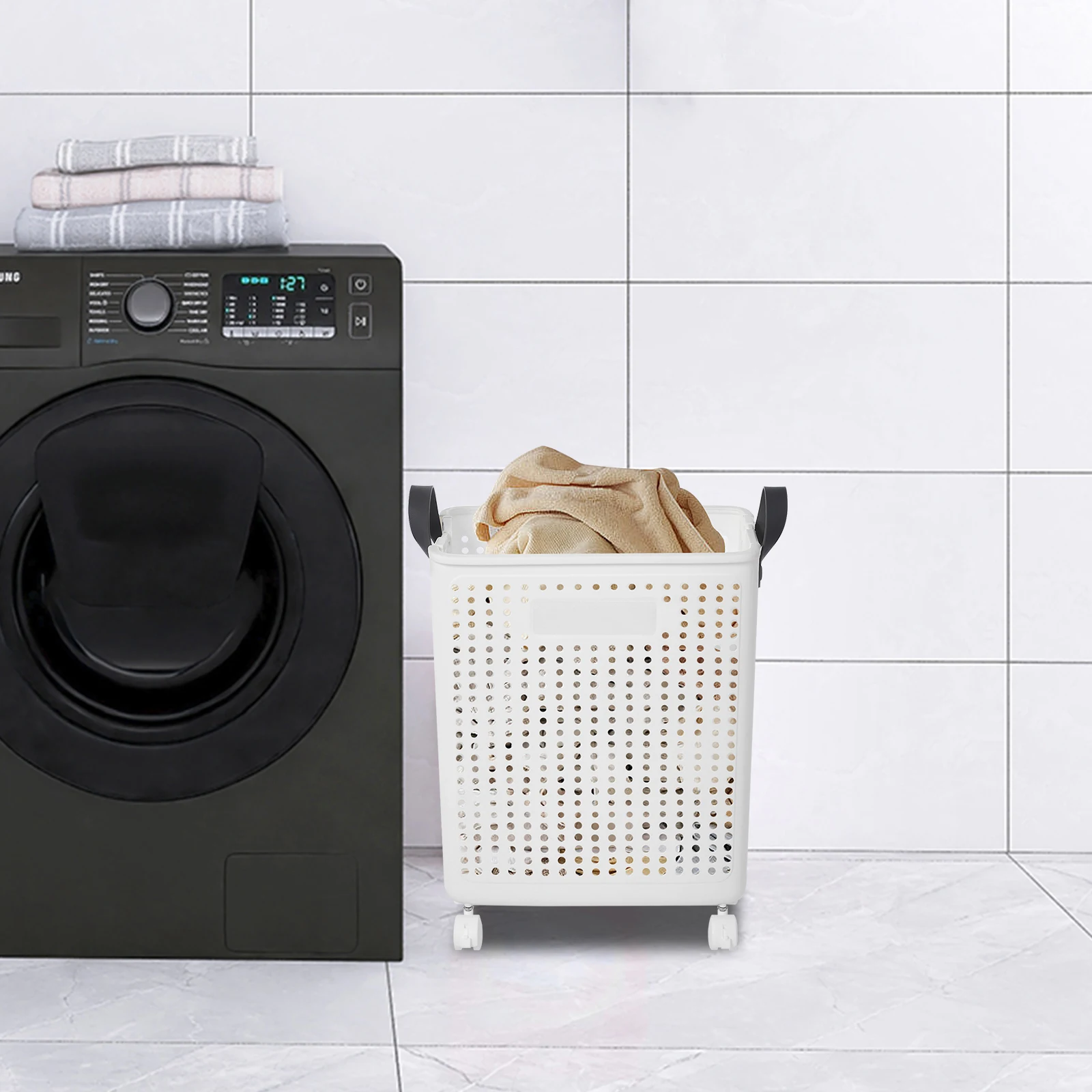
While lidded hampers offer many advantages, certain situations may make open-top designs the more practical choice. Consider these scenarios where an open hamper might better serve your needs:
Consistently Dry Laundry: If your laundry rarely includes damp items—no workout clothes, limited towels, or climate-controlled environments with low humidity—ventilation becomes less crucial. However, even in these cases, the open design allows for maximum airflow, preventing any moisture buildup from daily wear.
Well-Ventilated Locations: Hampers placed in areas with excellent air circulation, such as well-ventilated laundry rooms or spacious bathrooms with exhaust fans, may not require lids for effective odor management. The environmental airflow can provide sufficient freshness without the need for containment.
Convenience Priority: For households where the slight extra effort of opening a lid might create a barrier to proper laundry habits, an open design removes this friction point. This consideration is especially relevant for families with teenagers or in high-traffic households where convenience directly impacts compliance with organization systems.
Very Frequent Laundering: If you wash clothes daily or every other day, laundry doesn’t remain in the hamper long enough for odors or moisture to become problematic. In these cases, the simplicity of an open woven laundry basket might be preferable to a more complex lidded design.
Visual Reminder Benefit: Some households actually benefit from seeing their accumulating laundry as a reminder to maintain regular washing schedules. An open hamper provides this visual cue, potentially helping establish more consistent laundry habits.
These scenarios highlight that the “best” hamper design varies significantly based on individual circumstances and preferences. Neither option is universally superior—your specific situation should guide your choice.
Expert Tips for Getting the Most from Your Lidded Hamper
If you’ve decided that a lidded hamper is right for your home, these practical tips will help you maximize its benefits while minimizing potential drawbacks:
Ensure Proper Drying Before Storage: Whenever possible, allow damp items like towels and workout clothes to air dry before placing them in your hamper. Even just hanging them over the shower rod or doorknob for 30 minutes can significantly reduce moisture levels and prevent mildew development inside your hamper.
Select Hampers with Ventilation Features: Look for lidded designs that incorporate strategic ventilation through material choice or design elements. Natural fiber hampers like those made from wicker or rattan provide inherent breathability, while some plastic or fabric options include mesh panels or perforations that facilitate airflow without sacrificing containment.
Practice Proper Capacity Management: Resist the temptation to overfill your hamper, as compressed clothing retains more moisture and allows less air circulation. Large wicker laundry baskets provide ample capacity for proper storage without cramming, which helps maintain better freshness between wash days.
Establish Regular Cleaning Routines: The hamper itself needs occasional cleaning to prevent odor buildup. For fabric liners, regular washing according to care instructions keeps them fresh. For wicker or plastic hampers, periodic wiping with a mild disinfectant solution helps eliminate accumulated bacteria and odors.
Implement Periodic Airing: Consider leaving the lid open occasionally when the hamper is in a private area (like during shower steam in bathrooms) to allow for additional air circulation. This periodic airing can help release trapped moisture without compromising the benefits of the lid during normal use.
Wicker Laundry Baskets, Woven Laundry Baskets, Woven Storage Baskets
$392.02 Select options This product has multiple variants. The options may be chosen on the product pageLarge Wicker Laundry Baskets, Tall Wicker Baskets, Woven Laundry Hampers, Woven Storage Baskets
$130.54 Select options This product has multiple variants. The options may be chosen on the product pageWoven Laundry Baskets, Woven Laundry Washing Baskets
Price range: $136.76 through $581.37 Select options This product has multiple variants. The options may be chosen on the product pageWicker Hampers with Lids, Wicker Laundry Baskets with Lids, Wicker Laundry Hampers
$127.33 Select options This product has multiple variants. The options may be chosen on the product pageWicker Blanket Baskets, Woven Laundry Baskets
$89.60 Select options This product has multiple variants. The options may be chosen on the product pageLarge Wicker Laundry Baskets, Rattan Laundry Baskets, Woven Laundry Hampers
$162.32 Select options This product has multiple variants. The options may be chosen on the product page
With these practical strategies, you’ll enjoy all the benefits of your lidded hamper while effectively managing the potential downsides, creating an optimal laundry storage solution for your home.
Making the Final Decision: Is a Lidded Hamper Right for You?
After considering the various factors that influence hamper selection, it’s time to make your decision. While personal preference plays a significant role, this framework will help you make a choice that truly addresses your specific needs:
Begin by identifying your primary concerns. Is odor containment your main priority? Do you have pets or children accessing your laundry? Is aesthetic appeal in a visible location most important? Or is maximum ventilation for damp items your chief concern? Recognizing your top priority helps clarify which hamper features matter most.
Next, consider which benefits would make the biggest difference in your daily life. A lidded hamper excels at:
– Containing odors and maintaining room freshness
– Creating visual tidiness and aesthetic appeal
– Providing security from pets and children
– Preventing overflow and spillage
Meanwhile, open hampers offer advantages in:
– Maximum ventilation and moisture control
– Convenient access without handling lids
– Visual reminders to do laundry
– Often slightly lower cost and space requirements
The ideal choice acknowledges that no single design is perfect, but one will better address your specific priorities. Ask yourself these final questions:
– Where will my hamper be located?
– What types of laundry will typically fill it?
– How long will items remain in the hamper before washing?
– Who else in my household will interact with it?
Your answers will guide you toward the option that best balances your unique requirements.
Finding Premium Hamper Options for Your Home
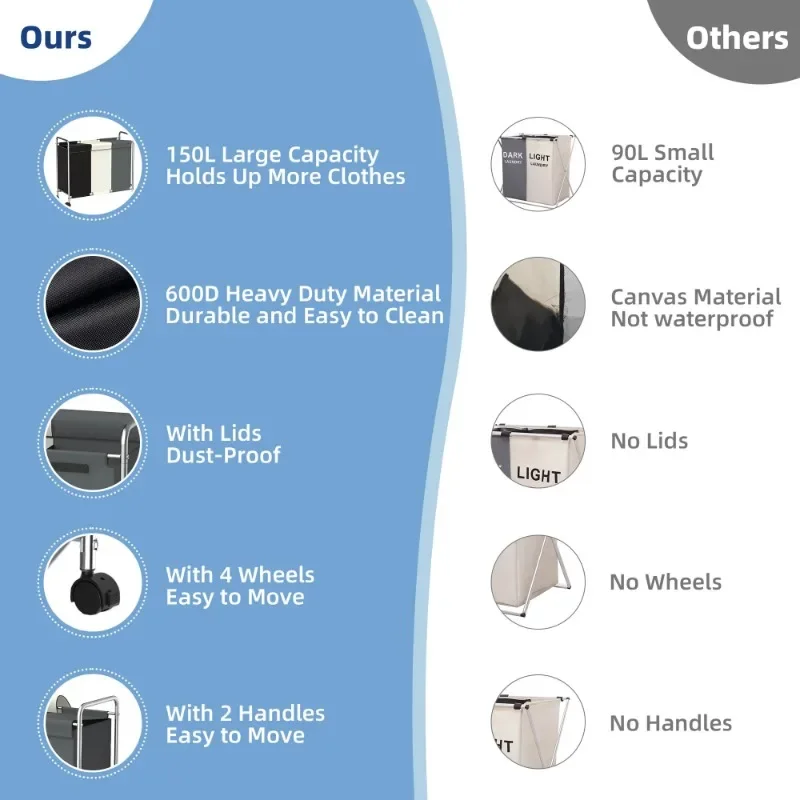
When investing in a laundry hamper that will serve your home for years to come, quality considerations become particularly important. Premium hampers distinguish themselves through superior construction, thoughtful design features, and materials that balance function with visual appeal.
High-quality hampers typically feature reinforced handles, precisely finished edges, and durable closures that withstand years of daily use. Look for seamless weaving patterns in natural materials, sturdy hardware in hinged designs, and quality stitching in fabric options. These construction details directly impact longevity and performance.
The investment in quality particularly pays off in lidded designs, where closure mechanisms face repeated use. Premium options offer smoother operation, quieter closing, and more reliable performance over time. Additionally, higher-quality materials like genuine rattan and hand-woven wicker provide better airflow characteristics than their synthetic counterparts.
Natural materials offer benefits beyond basic functionality, bringing warmth and texture to your space. Wicker laundry hampers from Tidy Treasure exemplify how these traditional materials can be reimagined for contemporary homes, combining timeless appeal with practical performance. Their breathable nature strikes an ideal balance between ventilation and containment, addressing one of the primary concerns with lidded designs.
When selecting your hamper, consider how it will integrate with your overall home aesthetic. The best options serve as design elements in their own right, complementing your existing décor while performing their practical function beautifully.
Frequently Asked Questions About Laundry Hampers With Lids
Can lidded hampers completely eliminate odors?
While lidded hampers significantly reduce odor transmission, they can’t completely eliminate odors from developing inside the hamper itself. The best approach combines a quality lidded hamper with good laundry habits like allowing damp items to dry before storage and washing clothes regularly. Hampers made from natural materials that allow some airflow typically manage odors better than completely sealed containers.
How often should I clean my hamper?
Fabric liners should ideally be washed every 1-2 months with regular use, while the hamper structure itself benefits from monthly wiping with a mild disinfectant solution. If you frequently store very soiled or sweaty clothes, more frequent cleaning may be necessary. Watch for lingering odors that remain even when the hamper is empty as a sign that cleaning is needed.
Are there lidded options that still allow for good ventilation?
Yes, many premium hampers specifically address this concern through design. Look for wicker, rattan, or bamboo construction with natural gaps in the weave pattern, fabric hampers with mesh panels, or plastic options with strategic ventilation holes. These designs maintain air circulation while still providing the benefits of a lid.
Do lidded hampers take up more space than open ones?
Lidded hampers typically require slightly more vertical clearance to accommodate the lid’s opening arc. However, this difference is minimal in most designs. The footprint remains comparable between lidded and open options of similar capacity. Some space-efficient designs feature flip-tops or front-opening doors that require less overhead clearance.
Are there child-proof or pet-proof lid options available?
Several hamper designs incorporate secure closures specifically to deter pets and children. Look for options with magnetic closures, latching mechanisms, or weighted lids that resist easy opening. However, keep safety in mind—avoid any closure that could potentially trap or injure curious little ones.

